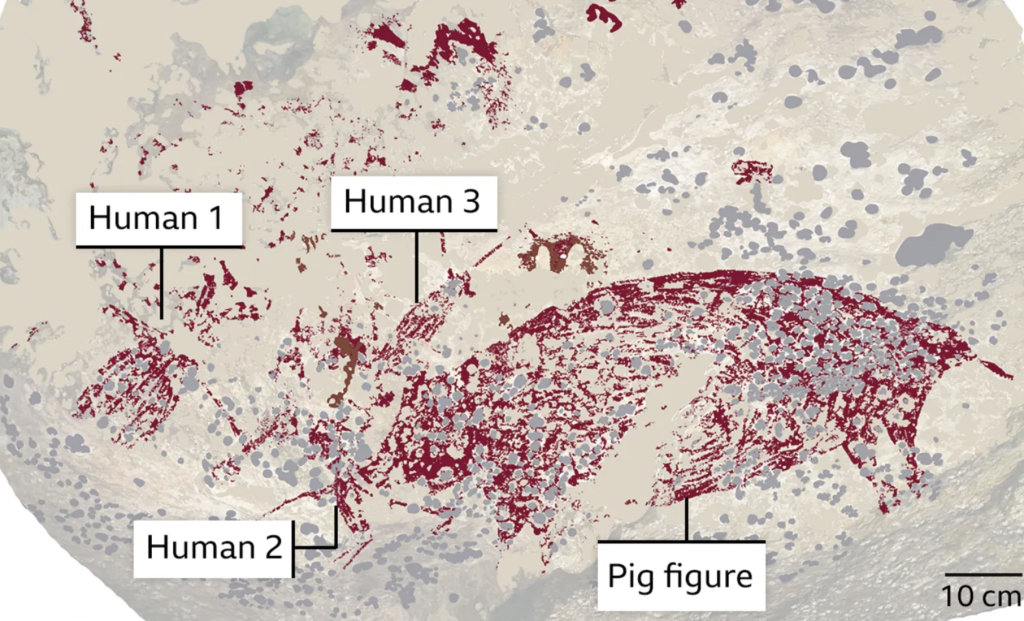Introduction
A groundbreaking discovery has been made on the Indonesian island of Sulawesi, where Australian and Indonesian scientists have unearthed the oldest known example of figurative cave art. This remarkable painting, depicting a wild pig and three human-like figures, dates back at least 51,200 years, surpassing the previous oldest cave art by over 5,000 years.
Rewriting Human Evolution
Professor Maxime Aubert from Griffith University in Australia emphasized the profound implications of this discovery. “The painting tells a complex story. It is the oldest evidence we have for storytelling. It shows that humans at the time had the capacity to think in abstract terms,” he explained to BBC News.
Depicting a Narrative
The artwork portrays a pig standing still with its mouth partially open, accompanied by at least three human-like figures. The largest figure, with arms extended, appears to be holding a rod. Another figure stands in front of the pig, with its head near the snout, seemingly holding a stick that may be in contact with the pig’s throat. The third human-like figure, upside-down with splayed legs, reaches towards the pig’s head.
Scientific Collaboration
The research team was led by Adhi Agus Oktaviana, an Indonesian rock art specialist from the National Research and Innovation Agency (BRIN) in Jakarta. Oktaviana highlighted the significance of narrative storytelling in early human culture in Indonesia. “Humans have probably been telling stories for much longer than 51,200 years, but as words do not fossilize, we can only go by indirect proxies like depictions of scenes in art – and the Sulawesi art is now the oldest such evidence by far that is known to archaeology,” he stated.
Evolution of Art
While the first evidence of drawing, consisting of geometric patterns, was found on rocks in the Blombos Caves in southern Africa and dates back to between 75,000 and 100,000 years ago, the Sulawesi painting represents an evolution in human thought processes. The artwork in the limestone cave of Leang Karampuang in the Maros-Pangkep region signifies the emergence of representational art, an abstract depiction of the world around the artists.

The Human Mind’s Awakening
Dr. Henry Gee, a senior editor at the journal Nature, where the discovery was published, posed the question of what triggered this awakening of the human mind. “Something seems to have happened around 50,000 years ago, shortly after which all other species of humans such as Neanderthals and the so-called Hobbit died out,” he noted. However, Gee suggests that even earlier examples of representational art might exist.
A Broader Perspective
Professor Chris Stringer of the Natural History Museum in London believes that ancient representational art may have originated in Africa, where modern humans first evolved. “This find reinforces the idea that representational art was first produced in Africa, before 50,000 years ago, and the concept spread as our species spread,” he said. Stringer emphasizes the need for further dating at multiple sites to confirm these findings.
New Dating Techniques
The new dating method, which involves cutting tiny amounts of the art using a laser, has enabled researchers to study different parts of the artwork in greater detail, leading to more accurate dating. As this method becomes more widely used, it could potentially re-date cave art sites worldwide, pushing back the emergence of representational art even further.
Changing Perspectives on Art Origins
Until a decade ago, ancient cave art evidence was primarily found in Spain and Southern France, leading to the belief that the creative explosion that gave rise to modern art and science began in Europe. However, the discovery of colored outlines of human hands in South Sulawesi in 2014 challenged this view.
Continued Discoveries
In November 2018, scientists found what was then the oldest representational artwork in the cave of Lubang Jeriji Saléh on the Indonesian island of Borneo, depicting an unknown animal over 40,000 years old. Professor Adam Brumm from Griffith University remarked on the significance of the latest Indonesian cave art discoveries. “It is noteworthy that the oldest cave art we have found in Sulawesi thus far consists of recognizable scenes: paintings that depict humans and animals interacting in such a way that we can infer the artist intended to communicate a narrative of some kind – a story,” he said.
Conclusion
The discovery of the oldest figurative cave art on Sulawesi Island not only pushes back the timeline for the emergence of representational art but also sheds light on the important role of storytelling in early human culture. As new dating methods continue to refine our understanding, the history of human creativity and thought may be further rewritten.
Feature Image: The painting is the earliest known example of representational art | Courtesy: BBC





